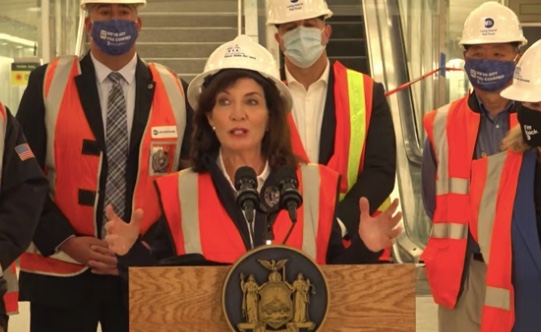Governor Kathy Hochul today directed state agencies to prepare emergency response assets as a coastal storm system could deliver up to a foot of snow and gusty winds in some downstate locations this weekend. Heavy snow is possible starting Friday evening for parts of Long Island, New York City and the Mid-Hudson regions with some areas expected to receive 6 to 12 inches or more by Saturday night. Winds gusting up to 55 mph at times will likely impact travel in several locations and could potentially cause power outages.
“A winter storm system moving up the coast has the potential to deliver heavy snow, gusty winds, and create dangerous travel conditions across downstate locations this weekend, especially in Long Island, New York City and the Mid-Hudson Region,” Governor Hochul said. “We are monitoring forecasts and making emergency response preparations for whatever this storm system throws our way. As we head into the weekend, I encourage New Yorkers to closely follow their local weather forecasts, stay off the roads and avoid unnecessary travel.”
A Winter Storm Watch has been issued for Long Island, New York City, and some locations in the Mid-Hudson Region. National Weather Service meteorologists advise there is some uncertainty regarding the track of this storm and snowfall may shift in future forecasts. For a complete listing of weather advisories in your area, visit the National Weather Service website.
Agency Preparations
Division of Homeland Security and Emergency Services
The New York State Division of Homeland Security and Emergency Services’ Emergency Operations Center is activated and will closely monitor conditions, coordinate response operations, and remain in contact with localities throughout the duration of the event. State stockpiles are prepared to deploy assets to localities to support any storm-related needs, including pumps, chainsaws, sandbags, generators, cots, blankets, and bottled water.
Department of Transportation
The State Department of Transportation is responding to the current weather event in multiple regions with the following assets:
- 1596 large snow plows
- 322 large loaders
- 143 medium duty plows
- 51 tow plows
- 39 snowblowers
- 23 pickup trucks with plows
- 20 graders
For up-to-date travel information, call 511, visit https://www.511ny.org or download the free 511NY mobile app.
Thruway Authority
The Thruway Authority has 681 operators and supervisors ready to respond with 240 large snow plows, 117 medium snow plows, 11 tow plows and 66 loaders across the state with more than 119,000 tons of road salt on hand.
Variable Message Signs and social media are utilized to alert motorists of winter weather conditions on the Thruway.
The Thruway Authority encourages motorists to download its mobile app which is available for free on iPhone and Android devices. The app provides motorists direct access to real-time traffic and navigation assistance while on the go. Motorists can also sign up for TRANSalert e-mails which provide the latest traffic conditions along the Thruway here.
Department of Environmental Conservation
DEC Environmental Conservation Police Officers, Forest Rangers, Emergency Management staff, and regional staff are on alert and monitoring the developing situation and actively patrolling areas and infrastructure impacted by severe weather. All available assets are positioned to assist with any emergency response.
Office of Parks, Recreation and Historic Preservation
New York State Park Police and park personnel are on alert and closely monitoring weather conditions and impacts. Park visitors should check parks.ny.gov or call their local park office for the latest updates regarding park hours, openings, and closings.
Department of Public Service
New York’s utilities have approximately 5,500 workers available to engage in damage assessment, response, and restoration efforts across New York State. Agency staff will track utilities’ work throughout the event and ensure utilities shift appropriate staffing to regions anticipated to be most impacted.
New York State Police
State Police are prepared to deploy additional Troopers as needed to affected areas. All State Police four-wheel drive and specialized vehicles are staged and ready for immediate response, and all emergency power and communications equipment has been tested.
New York Power Authority / Canal Corporation
The New York Power Authority and the Canal Corporation staff are performing preparations to ensure all facilities, assets and equipment are secured and ready. The Power Authority is prepared to support power restoration activities if needed.
Metropolitan Transportation Authority
The MTA is closely monitoring weather conditions to ensure safe, reliable service. MTA employees will be poised to spread salt, clear platforms and stairs where ice exists, and keep signals, switches, and third rail operating, remove any downed trees that may fall across tracks, and attend to any weather-related challenges during the storm. MTA Bridges and Tunnels is advising motorists to use caution when driving on icy roadways and drive at reduced speeds.
Customers are encouraged to check new.mta.info for the latest service updates, and to use caution while navigating the system. Customers should also sign up for real-time service alerts via text or email. These alerts are also available via the MTA’s apps: MYmta, Long Island Rail Road Train Time and Metro-North Train Time.
Port Authority of New York and New Jersey
The Port Authority is monitoring weather conditions. Speed restrictions may be in effect at the bridges, as well as along roadways to and from the crossings. Passengers through the Port Authority’s facilities are encouraged to reach out to carriers and airlines directly for the latest information on delays and cancelations. For the latest information about Port Authority facilities, please check social media, sign up for PA alerts or download one of the PA mobile apps, including RidePATH which provides real-time updates and alerts for PATH service.
Safety Tips
Winter Travel
The leading cause of death and injuries during winter storms is transportation accidents.
Before getting behind the wheel, make sure that your vehicle is clear of ice and snow; good vision is key to good driving. Plan your stops and keep more distance between cars. Be extra alert and remember that snowdrifts can hide smaller children. Always match your speed to the road and weather conditions.
It is important for motorists on all roads to note that snowplows travel at speeds up to 35 mph, which in many cases is lower than the posted speed limit, to ensure that salt being dispersed stays in the driving lanes and does not scatter off the roadways. Oftentimes on interstate highways, snowplows will operate side by side, as this is the most efficient and safe way to clear several lanes at one time.
Motorists and pedestrians should also keep in mind that snowplow drivers have limited lines of sight, and the size and weight of snowplows can make it very difficult to maneuver and stop quickly. Snow blowing from behind the plow can severely reduce visibility or cause whiteout conditions. Motorists should not attempt to pass snowplows or follow too closely. The safest place for motorists to drive is well behind the snowplows where the roadway is clear and salted.
Some of the most important tips for safe driving include:
- When winter storms strike, do not drive unless necessary.
- Use caution on bridges as ice can form quicker than on roads.
- Wet leaves on roadways can cause slippery conditions, making it important to drive at slower speeds when approaching patches of them.
- Make sure your car is stocked with blankets, a shovel, flashlight and extra batteries, extra warm clothing, set of tire chains, battery booster cables, quick-energy foods and brightly colored cloth to use as a distress flag.
- Keep your gas tank full to prevent gasoline freeze-up.
- If you have a cell phone or two-way radio available for your use, keep the battery charged and keep it with you whenever traveling. If you should become stranded, you will be able to call for help, advising rescuers of your location.
- Make sure someone knows your travel plans.
- While driving, keep vehicles clear of ice and snow.
- Plan stops and keep distance between cars. Always match your speed to the road and weather conditions.
It’s important to note that snowplows travel at speeds up to 35 mph, which in many cases is lower than the posted speed limit, to ensure that salt being dispersed stays in the driving lanes and does not scatter off the roadways. Oftentimes on interstate highways, snowplows will operate side by side, as this is the most efficient and safe way to clear several lanes at one time.
Motorists and pedestrians should also keep in mind that snowplow drivers have limited lines of sight, and the size and weight of snowplows can make it very difficult to maneuver and stop quickly. Snow blowing from behind the plow can severely reduce visibility or cause whiteout conditions. Motorists should not attempt to pass snowplows or follow too closely. The safest place for motorists to drive is well behind the snowplows where the roadway is clear and salted.
Power Outage
If experiencing a power outage, New Yorkers should:
- Turn off or disconnect major appliances and other equipment, e.g., computers, in case of a momentary power surge that can damage these devices. Keep one light turned on so you know when power returns. Consider using surge protectors wherever you use electronic equipment.
- Call your utility provider to notify them of the outage and listen to local broadcasts for official information. For a list of utilities, visit the State Department of Public Service.
- Check to see if your neighbors have power. Check on people with access or functional needs.
- Use only flashlights for emergency lighting – candles pose the risk of fire.
- Keep refrigerators and freezer doors closed – most food requiring refrigeration can be kept safely in a closed refrigerator for several hours. An unopened refrigerator will keep food cold for approximately four (4) hours. A full freezer will keep the temperature for about 48 hours.
- Do not use a charcoal grill indoors and do not use a gas stove for heat – they could give off harmful levels of carbon monoxide.
- In cold weather, stay warm by dressing in layers and minimizing time spent outdoors. Be aware of cold stress symptoms (i.e., hypothermia) and seek proper medical attention if symptoms appear.
- If you are in a tall building, take the stairs and move to the lowest level of the building. If trapped in an elevator, wait for assistance. Do not attempt to force the doors open. Remain patient – there is plenty of air and the interior of the elevator is designed for passenger safety.
- Remember to provide fresh, cool water for your pets.
- Eliminate unnecessary travel, especially by car. Traffic signals will stop working during an outage, creating traffic congestion and dangerous driving conditions. If you must drive during a blackout, remember to obey the 4-way stop rule at intersections with non-functioning traffic signals.
- Remember that equipment such as automated teller machines (ATMs) and elevators may not be working.















